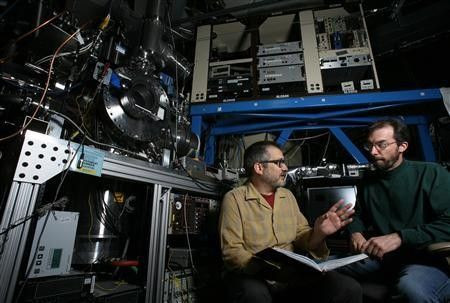New Molecule Could Help Cool Planet

(Reuters) - A new molecule has been detected in the earth's atmosphere which could help produce a cooling effect, scientists said, but it remains to be seen whether it can play a major role in tackling global warming.
The molecule can convert pollutants, such as nitrogen dioxide and sulphur dioxide, into compounds which can lead to cloud formation, helping to shield the earth from the sun, the researchers said.
Over the past century, the earth's average temperature has risen by 0.8 degrees Celsius. Scientists say the increase must be limited to below two degrees Celsius this century to prevent rising sea levels and other unwelcome consequences.
But mainstream ways of curbing warming, such as renewable power and energy efficiency, are not delivering results fast enough.
In a paper published in the journal Science on Thursday, researchers from the Universities of Manchester and Bristol, and the U.S.-based Sandia National Laboratories detected the new molecules, called Criegee biradicals, using a powerful light source 100 million times stronger than the sun.
"We found the biradicals could oxidise sulfur dioxide, which eventually turns into sulphuric acid, which has a known cooling effect," Carl Percival, one of the study's authors and a reader in atmospheric chemistry at the University of Manchester, told Reuters.
However, it is too early to predict how many molecules would have to be formed to make a substantial impact on the world's temperature and their safety would have to be tested.
The effects of cloud formation on the climate are also still far from understood.
COOLING OFF
When Mount Pinatubo in the Philippines erupted in 1991 it released huge amounts of sulphur dioxide, which formed a haze of sulphuric acid. This reduced the amount of sunlight which was able to reach the earth by about 10 percent, lowering global temperatures by around 0.5 degrees Celsius over two years.
However, high concentrations of sulphur dioxide injected into the atmosphere by large explosions could also cause lung ailments, acid rain, and the depletion of the earth's protective ozone layer.
"The biradicals themselves are not a geo-engineering candidate," Percival said, referring to radical ways of cooling the planet down, such as artificial volcanoes or whitening the clouds to make them reflect more sunlight.
The molecules detected by the research team occur naturally in the presence of alkenes, chemical compounds which are mostly released by plants.
"Plants will release these compounds, make the biradicals and end up making sulphuric acid, so in effect the ecosystem can negate the warming effect by producing these cooling aerosols," Percival said.
The greatest cooling effect could be potentially felt in areas where there are high concentrations of both alkenes and pollutants, which enable the biradicals to react.
"(The effect) would really kick in hot spots like Hong Kong or Singapore," Percival said.
© Copyright Thomson Reuters 2024. All rights reserved.




















